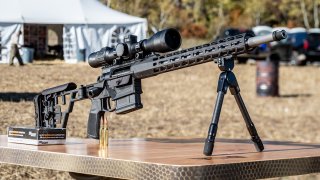The Sig CROSS: Has Sig Sauer Built the World's Best Bolt-Action Rifle?
Or not?
In late December, Sig Sauer, Inc. debuted its first bolt action rifle, the Sig CROSS. While Sig Sauer, Inc. (then known as SIGARMS, Inc.) sold bolt actions prior, the SSG 2000 and SSG 3000 were designed by Sig Sauer, GmbH in Germany, not by the U.S. division.
However, the SSG 2000 and SSG 3000 were relatively conventional designs, with a barreled receiver being placed in a one-piece stock/chassis. The Sig CROSS is radically different, featuring a one-piece receiver that accepts magazines, eliminating the chassis and stock. This leads to reduced weight and increased rigidity, though to the extent to which this is relevant is unclear, as most competition and military precision rifles continue to use the old system.
But the Sig CROSS’s use of a one-piece receiver has attracted controversy, as the rifle’s design highly resembles another one-piece receiver rifle, The Fix by Q, which was released in 2017. Q’s CEO, Kevin Brittingham, has taken to bashing Sig on Q’s Instagram page, describing the CROSS as “The Fix now offered in black with cheap Israeli plastic! Additional weight, rebates, and cut corners likely.” As Kevin Brittingham worked for Sig Sauer, Inc. in the past, some gun pundits have suggested that he worked on the predecessor of the CROSS prior to leaving and starting Q.
But The Fix wasn’t the first modular one-piece receiver rifle. EDM Arms made some of the first one-piece receiver rifles in the 1990s in their “Windrunner” series of rifles. However, these older rifles lack the long handguard and rail present on The Fix and the Sig CROSS rifles.
There are some odd quirks and differences between the rifles, though. The CROSS has a dust cover similar to an AR-style rifle. This is likely a gimmick feature as almost no other precision bolt action rifle has one. Dust covers were used on infantry bolt actions like certain trench modifications of the Gewehr 98, or on the Japanese Arisaka-series of Mauser-derived rifles, but those rifles were meant to be used in extremely dirty conditions. It’s hard to see a hunter abusing their precision gun to the degree at which a dust cover would be required.
The CROSS uses Accuracy International Chassis System (AICS) mags, which are a standard in the precision rifle community. The Fix uses the cheaper SR-25 pattern magazines. AICS mags are known for accommodating longer bullets than SR-25 pattern magazines, so it’s possible that the CROSS may be preferred among shooters that use oddball ultra-long bullets.
The Fix’s handguard uses the proprietary Q-sert handguard system, while the Sig CROSS uses a standard M-LOK handguard. While this may appear to be a disadvantage for The Fix at a glance, M-LOK is generally considered to be not strong enough to reliably mount bipods on rifles, due to the relatively thin nature of the actual M-LOK attachment point in the standard. Mounting bipods directly on M-LOK can result in the bending of the M-LOK slots the bipod is mounted on due to the torque that is applied in regular bipod use. The Q-sert attachment design seems to be more robust, as such The Fix’s handguard design is superior for the purpose. As Q has used M-LOK on some of their other products like the Honey Badger and Sugar Weasel, the decision to go with Q-sert on The Fix is likely an acknowledgment of M-LOK’s shortcomings, and not a desire to simply make the rifle proprietary.
Whether the CROSS will be successful is yet to be seen. But with a street price of around 1600 USD, Sig Sauer is aiming squarely at would-be Fix owners with the CROSS.
Charlie Gao studied Political and Computer Science at Grinnell College and is a frequent commentator on defense and national security issues.
Image: Creative Commons.

